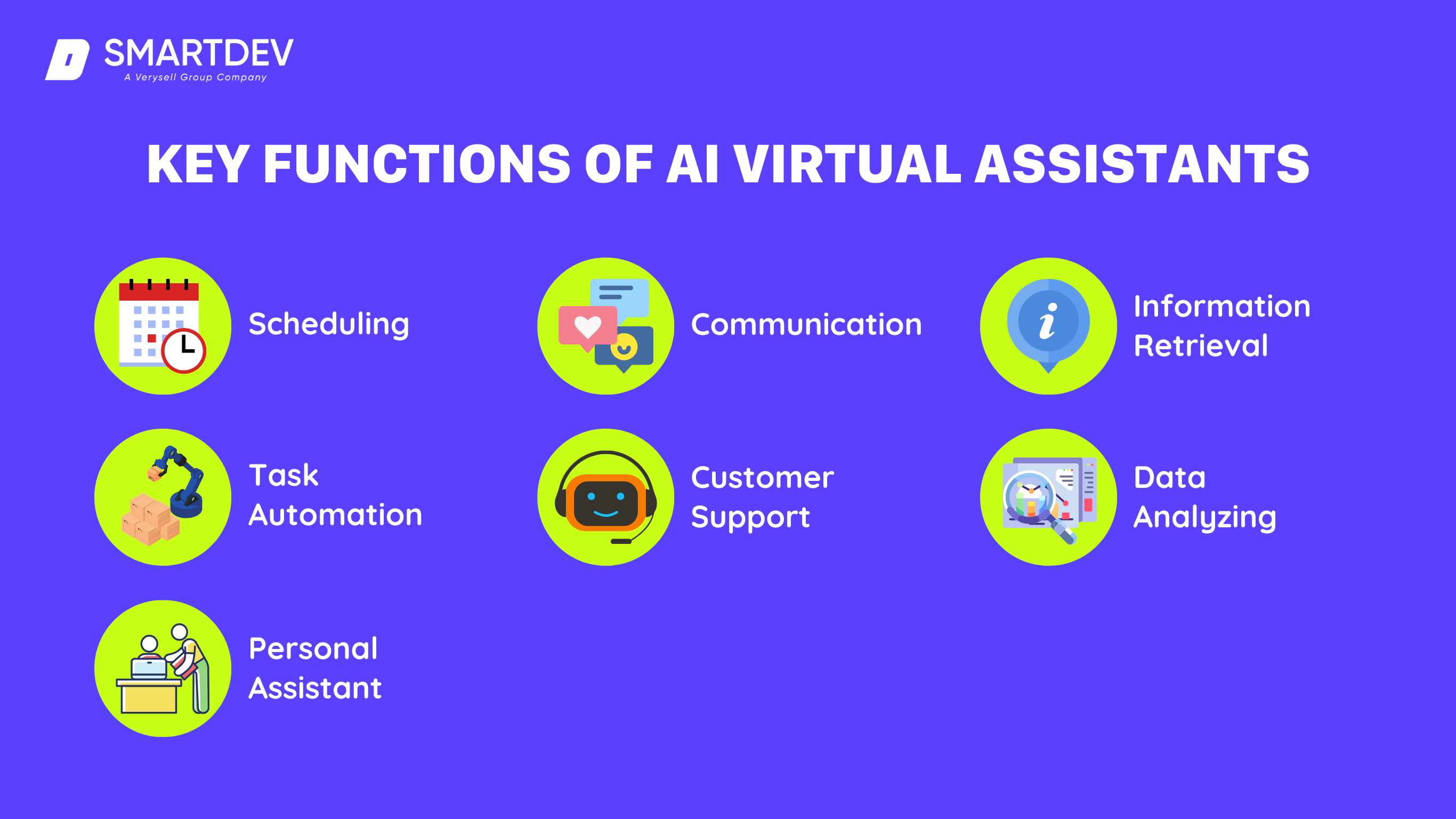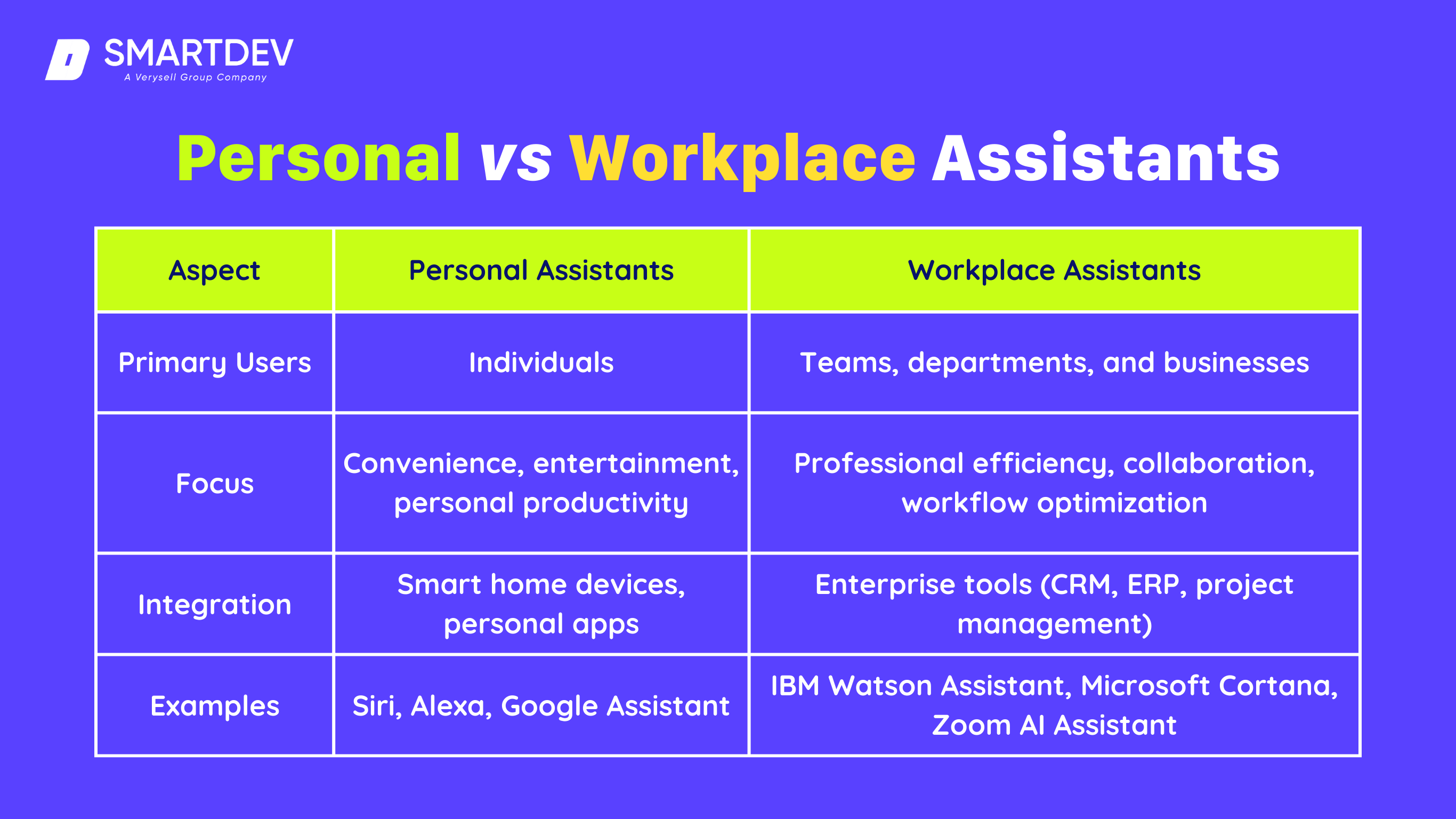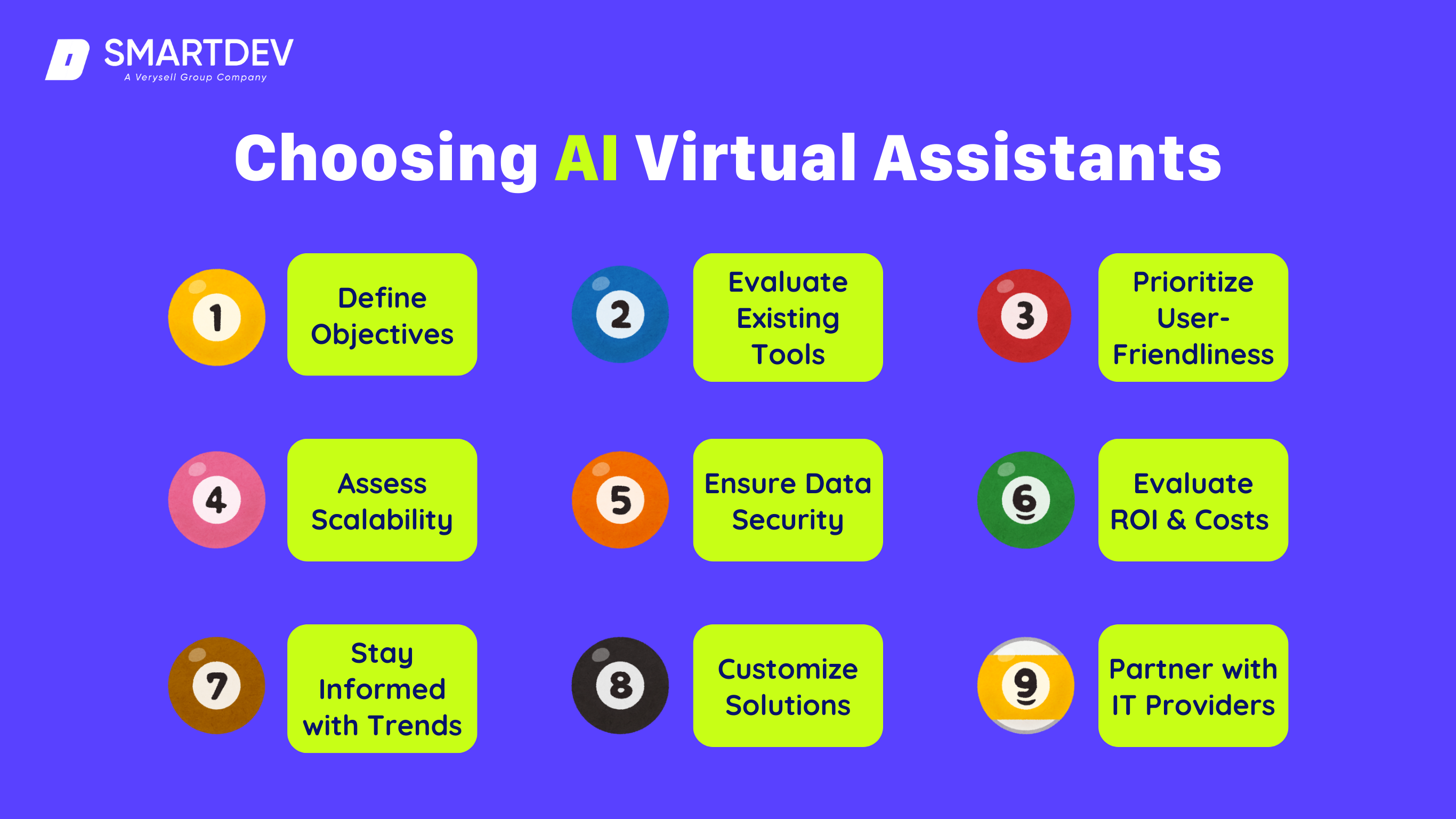AI-powered personal assistants have become an integral part of our daily lives. These virtual assistants, driven by cutting-edge AI technology, are revolutionizing the way we live and work. With their advanced capabilities and potential for future advancements, AI-powered personal assistants are shaping the future of virtual assistants.
(AI) has emerged as a transformative force in reshaping the way we work and communicate. In recent years, AI-powered personal assistants such as Siri, Alexa, and Google Assistant have become extremely popular. These virtual assistants utilize natural language processing and machine learning algorithms to comprehend and address user commands and inquiries. They can execute a wide array of tasks, ranging from setting reminders and sending messages to playing music and managing smart home devices
One of the most notable advancements in this technology space is the development of AI-powered virtual assistants, and among them, ChatGPT has taken the spotlight.
In this article, we’ll explore how AI-driven virtual assistants are revolutionizing the workplace.

Introduction
What is an AI-Powered Virtual Assistant?
A virtual assistant, also called an AI assistant or digital assistant, is an application program that understands natural language voice commands and completes tasks for the user. Such tasks – historically performed by a human personal assistant or secretary; include taking dictation, reading text or email messages aloud, looking up phone numbers, scheduling, placing phone calls, and reminding the user about appointments.
Unlike traditional automation tools, these assistants can understand context, learn from interactions, and adapt their responses for improved efficiency.
Virtual assistants can provide a wide variety of services, such as:
- Providing information, including weather, facts from sources like Wikipedia or IMDb, setting alarms, making to-do lists, and shopping lists.
- Playing music from streaming services like Spotify and Pandora, playing radio stations, and reading audiobooks
- Playing videos, TV shows, or movies on televisions, streaming from services like Netflix.
Overview of AI Virtual Assistant in the Workplace
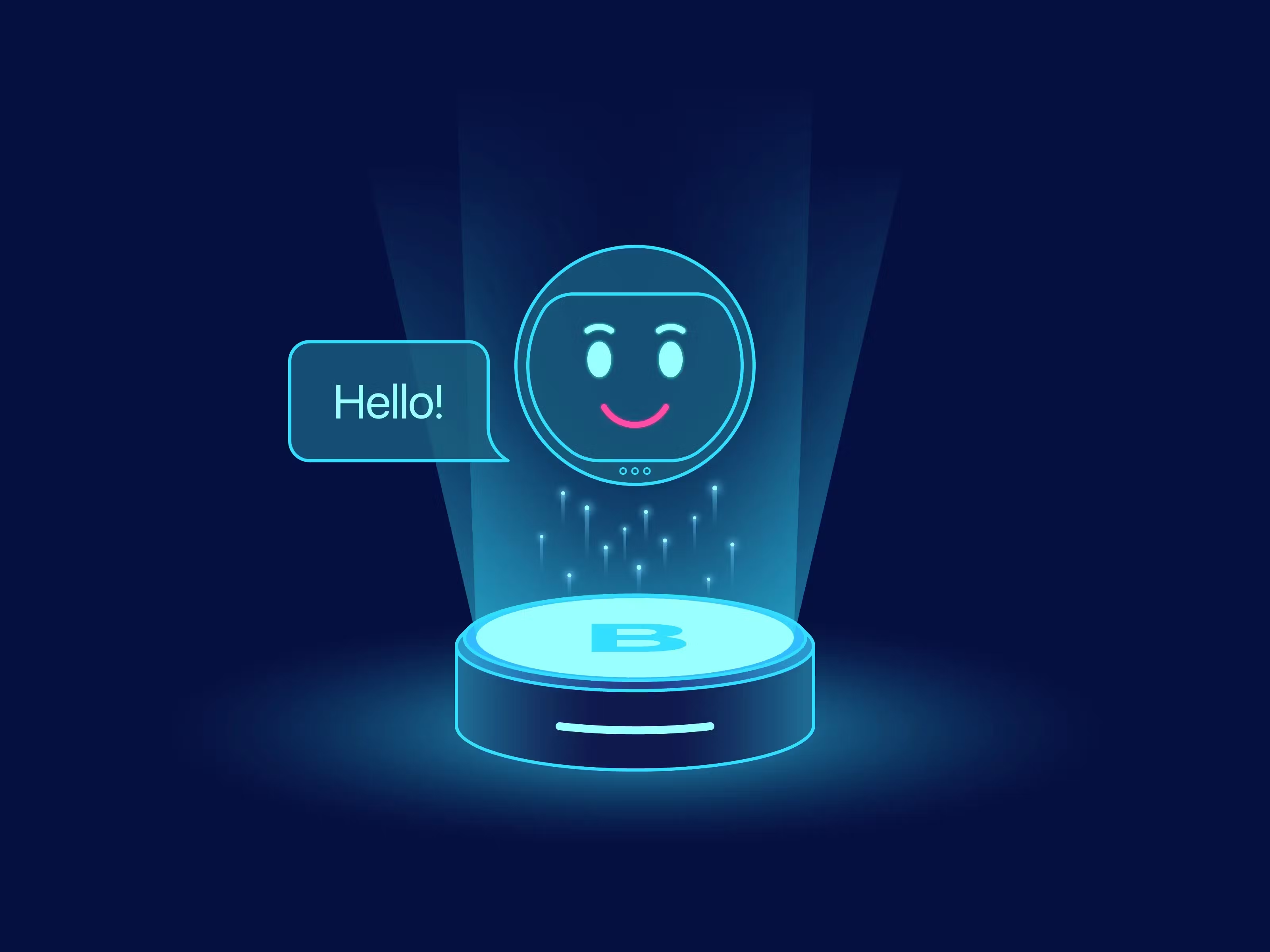
In today’s fast-paced business environment, efficiency and productivity are critical. AI-powered virtual assistants offer a solution by automating repetitive and time-consuming tasks. This allows employees to focus on strategic initiatives and creativity rather than mundane administrative duties.
For instance, companies that integrate AI assistants into their workflows report improved team collaboration, faster decision-making, and enhanced customer service. As digital transformation becomes a top priority for organizations worldwide, AI assistants are emerging as a cornerstone of this evolution.
As technology evolves, these assistants are expected to become even more integrated into our routines, shaping the future of personal and professional productivity. Here are some of the cutting-edge capabilities of AI-powered personal assistants:
- Natural Language Understanding: Natural Language Understanding (NLU) in AI assistants refers to the ability of computer software to comprehend and interpret human language, rather than just individual words. It enables AI assistants to analyze the sentiments, intentions, and implications behind a speaker’s statement, allowing for more natural and human-like interactions.
- Context Awareness: These virtual assistants can analyze contextual information to provide relevant and personalized responses. They can understand user preferences and adapt their behavior accordingly.
- Multi-Platform Integration: AI-powered personal assistants can seamlessly integrate with various platforms and devices, including smartphones, smart speakers, and smart home systems. This allows for a seamless and interconnected user experience.
- Voice Recognition: Voice recognition is a critical component of AI assistants, allowing them to understand and interpret spoken commands from users. Voice recognition software captures the user’s spoken command and converts it into text, which is then analyzed by natural language processing (NLP) algorithms to understand the intent of the user.
- Task Automation: AI technology empowers organizations to automate internal tasks by leveraging advanced algorithms and machine learning capabilities. By offloading repetitive and mundane tasks to AI systems, employees can focus on more engaging and challenging work, boosting job satisfaction and enhancing employee morale and retention. AI-powered task automation can encompass a wide range of features and capabilities, including natural language processing (NLP) for automated email responses, chatbot interactions, and voice recognition.
How AI-Powered Virtual Assistants Work
Behind every AI-powered virtual assistant lies a combination of cutting-edge technologies working seamlessly together. These systems are designed to understand human language, learn user preferences, and perform tasks with minimal input. From natural language processing to automation, the mechanics of AI virtual assistants are as fascinating as they are effective. Let’s break down the core technologies and functions that make these assistants invaluable.
1. Underlying Technologies
Natural Language Processing (NLP): Understanding What You Say
NLP is the part of the system that allows AI assistants to “listen” and “understand” human language, whether it’s spoken or typed. For example, when you say, “Schedule a meeting for tomorrow at 3 PM,” the assistant uses NLP to break this sentence into key components: the action (schedule), the subject (meeting), and the time (tomorrow at 3 PM). This enables the assistant to process your request just like a human would.
Machine Learning (ML): Learning Over Time
Machine learning is what makes AI assistants smarter as they go. The assistant observes how you interact with it and adapts to your habits. For instance, if you frequently ask for reminders about certain tasks at specific times, the assistant can anticipate these needs and might even suggest reminders proactively. Essentially, it “learns” your preferences to serve you better over time.
Automation: Getting the Job Done
Automation is the action step. Once the assistant understands your request, it executes the task by interacting with other systems or tools. For example, after processing your command to “schedule a meeting,” the assistant communicates with your calendar app, finds an open time slot, and sends invitations to participants. All of this happens in seconds without you needing to manually check or input details.
2. A Simple Example of How It All Comes Together
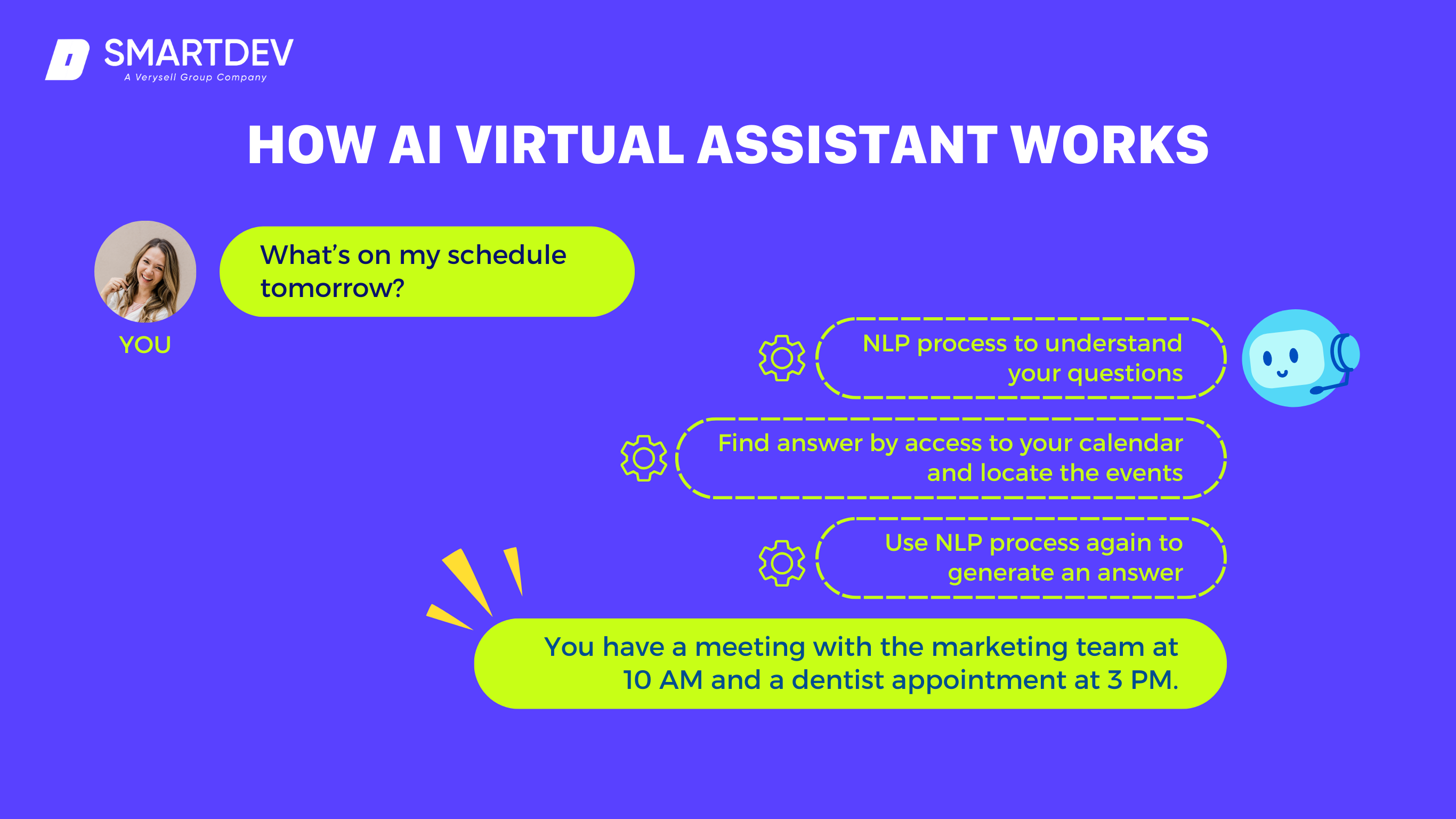
How AI Virtual Assistant Work
Imagine you ask your virtual assistant, “What’s on my schedule tomorrow?” Here’s what happens:
- Understanding: NLP processes your question and understands that you want information about your calendar.
- Finding Answers: The assistant uses its automation capabilities to access your calendar and locate tomorrow’s events.
- Responding: Using NLP again, generates a clear response like, “You have a meeting with the marketing team at 10 AM and a dentist appointment at 3 PM.”
The result? A smooth, conversational interaction that feels natural and saves you time.
By combining these three technologies, AI virtual assistants transform complex tasks into effortless interactions, even for users with minimal technical expertise. Whether it’s answering questions, setting reminders, or managing workflows, these tools work behind the scenes to make your day easier.
3. Key Functions
AI virtual assistants are designed to perform a wide range of functions that simplify everyday tasks and improve productivity. Here are some of the most common and practical uses:
a. Scheduling
AI assistants excel at managing schedules. You can ask them to set up meetings, send calendar invites, or remind you about important events. For instance, saying, “Schedule a team meeting for Friday at 10 AM,” prompts the assistant to check everyone’s availability and send out invites seamlessly.
b. Communication Assistance
From drafting emails to sending quick messages, AI assistants can help streamline communication. They can summarize lengthy email threads, suggest responses, or even handle customer queries in real-time, saving you from manually typing repetitive messages.
c. Information Retrieval
Need a quick answer or a document? AI assistants can fetch information from your database, files, or even the web. For example, asking, “What’s the revenue for Q3?” will have the assistant pull up the relevant report and summarize the data for you.
d. Task Automation
Routine tasks like setting reminders, creating to-do lists, and following up on deadlines are easily managed by AI assistants. For example, an assistant can remind you to submit a report every Friday without needing a new command each week.
e. Customer Support
AI-powered chatbots and virtual agents act as the first line of support for businesses. They can handle common customer inquiries, such as “Where is my order?” or “How do I reset my password?” This ensures faster responses and frees up human agents for more complex issues.
f. Data Analysis and Reporting
AI assistants are also capable of analyzing data and generating reports. For example, they can track your team’s weekly performance and provide insights like, “Your team completed 90% of assigned tasks this week, with a 10% improvement over last week.”
g. Personal Assistance
On a more personal level, these assistants can help you organize your life outside of work. They can provide weather updates, book appointments, and even manage smart home devices like turning off the lights or adjusting the thermostat.
Types of AI-Powered Virtual Assistants
AI-powered virtual assistants are not one-size-fits-all solutions. Depending on the context, these assistants are tailored to meet specific needs, whether for personal use or professional settings. While personal assistants like Siri or Alexa focus on individual productivity, workplace assistants are designed to enhance business operations. In this section, we’ll categorize AI virtual assistants to better understand their diverse applications.
1. Personal Assistants
Personal assistants like Siri, Alexa, and Google Assistant are built for individual users, aiming to simplify daily life. Their main focus is on convenience and accessibility, handling tasks such as managing personal schedules, controlling smart devices, and answering general knowledge questions.
Core Features of Personal Assistants
- Everyday Task Management: Setting alarms, reminders, or grocery lists.
- Smart Home Integration: Controlling lights, thermostats, or entertainment systems.
- Information Retrieval: Providing weather updates, news, or quick answers to queries like, “What’s the capital of France?”
- Entertainment: Playing music, streaming podcasts, or recommending movies.
Main Focus
Personal assistants prioritize ease of use and accessibility for everyday needs, often focusing on natural, conversational interactions. They are designed for individual users and provide utility in home, travel, or leisure settings.
Example: Asking Alexa to play your favorite playlist while you cook or instructing Google Assistant to remind you about an evening yoga class.
2. Workplace Assistants
Workplace assistants, such as IBM Watson Assistant, Microsoft Cortana, or Zoom AI Assistant, are built specifically for professional environments. These tools are designed to enhance productivity and streamline workflows in businesses by integrating with enterprise systems like CRMs, project management tools, and communication platforms.
Core Features of Workplace Assistants
- Scheduling and Coordination: Organizing meetings, managing calendars, and sending reminders.
- Collaboration Support: Facilitating team communication via platforms like Slack or Microsoft Teams.
- Data Management: Pulling reports, analyzing data, and delivering actionable insights.
- Customer Service Automation: Handling inquiries through chatbots or virtual agents.
Main Focus
Workplace assistants are geared toward optimizing operations, improving team collaboration, and automating repetitive tasks. Their focus is on driving efficiency and aligning with business goals rather than personal convenience.
Example: Using Zoom AI Assistant to transcribe meeting notes and create follow-up tasks for team members.
3. Key Differences Between Personal and Workplace Assistants
While personal assistants are designed to make your personal life easier, workplace assistants are focused on solving business challenges. The former helps you remember birthdays and control your home environment, while the latter ensures your team’s productivity by automating workflows and facilitating data-driven decisions.
Choosing between these types—or integrating both—depends on whether your priority is simplifying life or boosting workplace efficiency. Both types, however, represent the growing potential of AI to enhance our daily experiences.
Applications of AI Assistant in the Workplace
AI virtual assistants are not just tools—they are transformative technologies that redefine how work is done. By automating repetitive tasks, enhancing communication, and providing intelligent insights, these assistants have significantly altered traditional workflows. Let’s explore specific ways they are changing the workplace and examine real-world examples of their impact.
1. Task Management and Scheduling
Before AI: Scheduling meetings often required back-and-forth emails to find mutually available times, leading to delays and inefficiency.
With AI: Virtual assistants streamline this process by analyzing participants’ calendars, suggesting optimal meeting times, and sending automated invites.
Example:
Google Calendar’s AI scheduling assistant allows users to book meetings without manual intervention. For instance, companies like Salesforce use AI to manage executive calendars, reducing scheduling errors and saving hours of administrative effort each week.
Source: Tackle
2. Customer Service Automation
Before AI: Customer inquiries relied heavily on human agents, often leading to long wait times during peak hours.
With AI: Chatbots and voice assistants handle high volumes of customer queries 24/7, providing instant responses for routine issues like tracking orders or resetting passwords.
Example:
H&M implemented an AI chatbot to assist customers with product searches and order tracking, reducing call center workloads by 40% while improving customer satisfaction.

Source: Shopeline Academy
3. Internal Communication Enhancement
Before AI: Employees relied on email chains, lengthy team meetings, or manual updates to stay informed, leading to miscommunication and missed deadlines.
With AI: Virtual assistants summarize emails, generate meeting notes, and highlight action items to keep teams aligned.
Example:
Zoom’s AI-powered meeting assistant generates real-time transcriptions, summarizes discussions, and creates follow-up tasks, helping distributed teams stay on the same page and reduce post-meeting chaos.
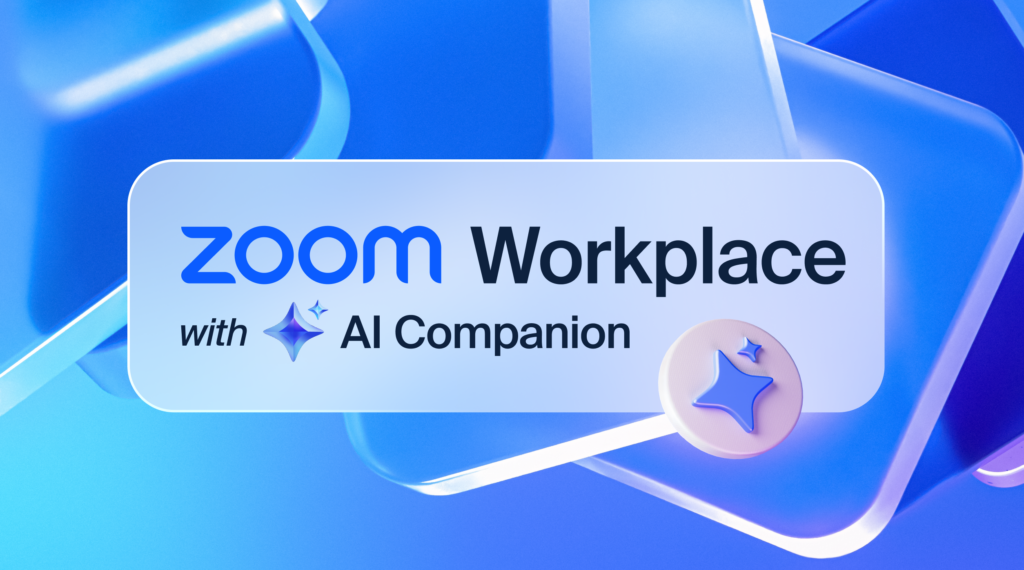
Source: Zoom
4. Data Analysis and Reporting
Before AI: Data analysis required manual extraction from various sources, often taking hours or even days to generate reports.
With AI: Virtual assistants connect with databases to analyze data instantly, presenting it in actionable formats like charts or summaries.
Example:
A financial services company integrated IBM Watson Assistant to analyze customer feedback and transaction data, reducing reporting time from several hours to just minutes. This helped managers make quicker, data-driven decisions.
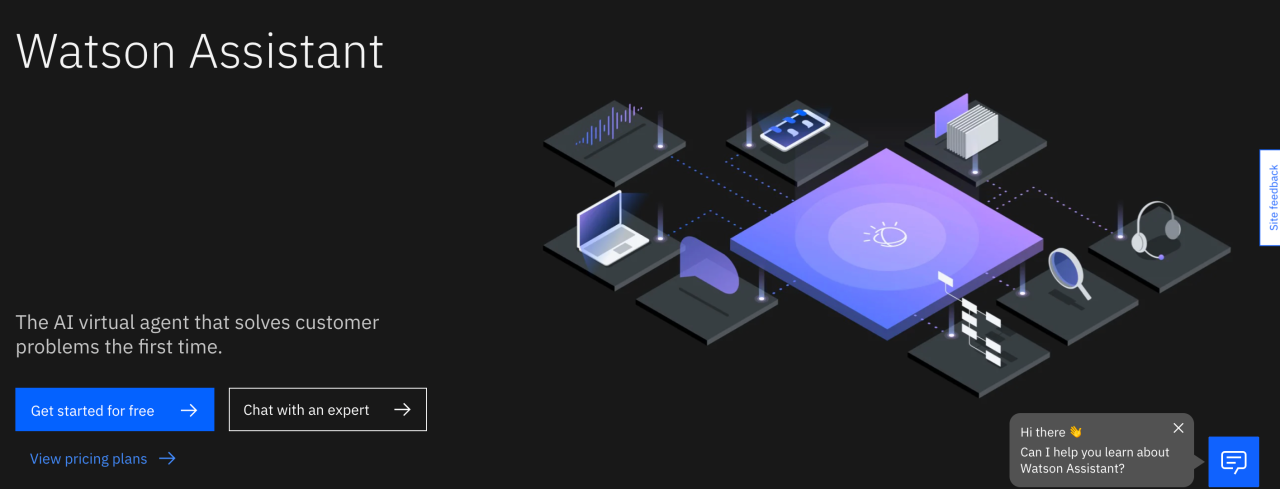
Source: IBM
5. Employee Onboarding and Training
Before AI: Onboarding new employees involved extensive paperwork, repetitive explanations, and manual guidance.
With AI: Virtual assistants simplify onboarding by automating administrative tasks, answering common questions, and guiding new hires through the process.
Example:
Unilever uses an AI-powered assistant named “Amber” to engage with new employees, answer FAQs, and provide personalized onboarding experiences, ensuring new hires feel supported and informed.
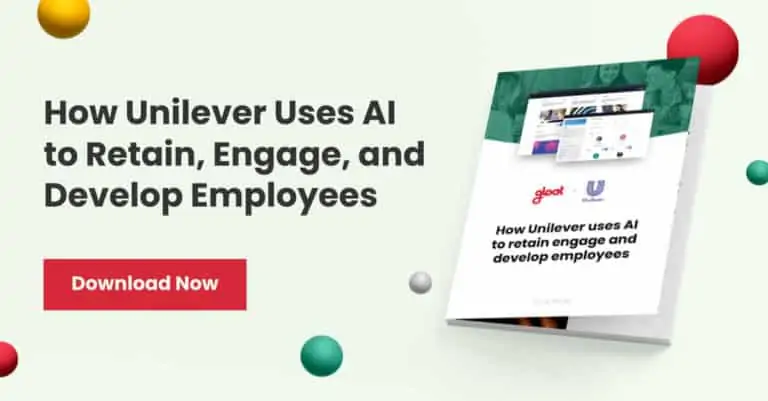
Source: Gloat
6. Human Resources Support
Before AI: HR teams spent significant time addressing repetitive employee queries related to leave policies, benefits, or payroll.
With AI: Virtual assistants handle these queries, freeing HR teams to focus on strategic initiatives.
Example:
Vodafone deployed an AI chatbot named “TOBi” to manage HR-related inquiries, reducing response times and improving employee satisfaction.
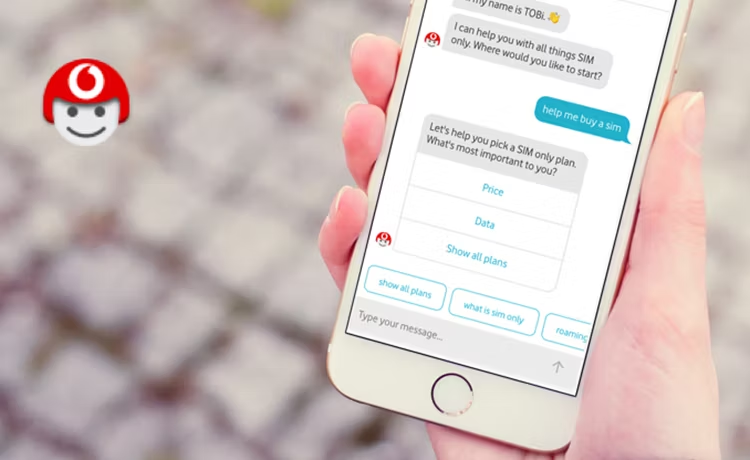
Source: Marketing Week
7. Content Creation and Management
Before AI: Content creation and management required significant human effort to organize, edit, and distribute materials.
With AI: Virtual assistants assist with drafting emails, generating content ideas, and managing workflows for creative teams.
Example:
Coca-Cola uses AI tools to generate personalized marketing content based on customer data, allowing their teams to focus on creative strategy rather than repetitive tasks

Source: The Coca-Cola Company
8. Compliance Monitoring and Reporting
Before AI: Ensuring compliance required manual checks, audits, and reviews, which were time-consuming and prone to human error.
With AI: Virtual assistants monitor compliance requirements, generate reports, and flag potential issues in real-time.
Example:
HSBC employs AI assistants to monitor financial transactions for compliance with anti-money laundering regulations, ensuring timely and accurate reporting.

Source: CNBC
9. Enhanced Multilingual Communication
Before AI: Overcoming language barriers required hiring multilingual staff or relying on slow manual translations.
With AI: Virtual assistants provide instant translations, allowing seamless communication across global teams.
Example:
Google Assistant’s interpreter mode enables real-time translations in over 40 languages, helping international businesses improve cross-cultural collaboration.
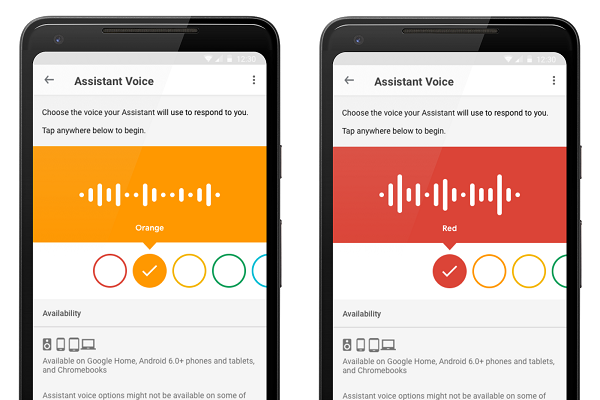
Source: Voicebot.ai
Benefits of AI-Powered Virtual Assistants
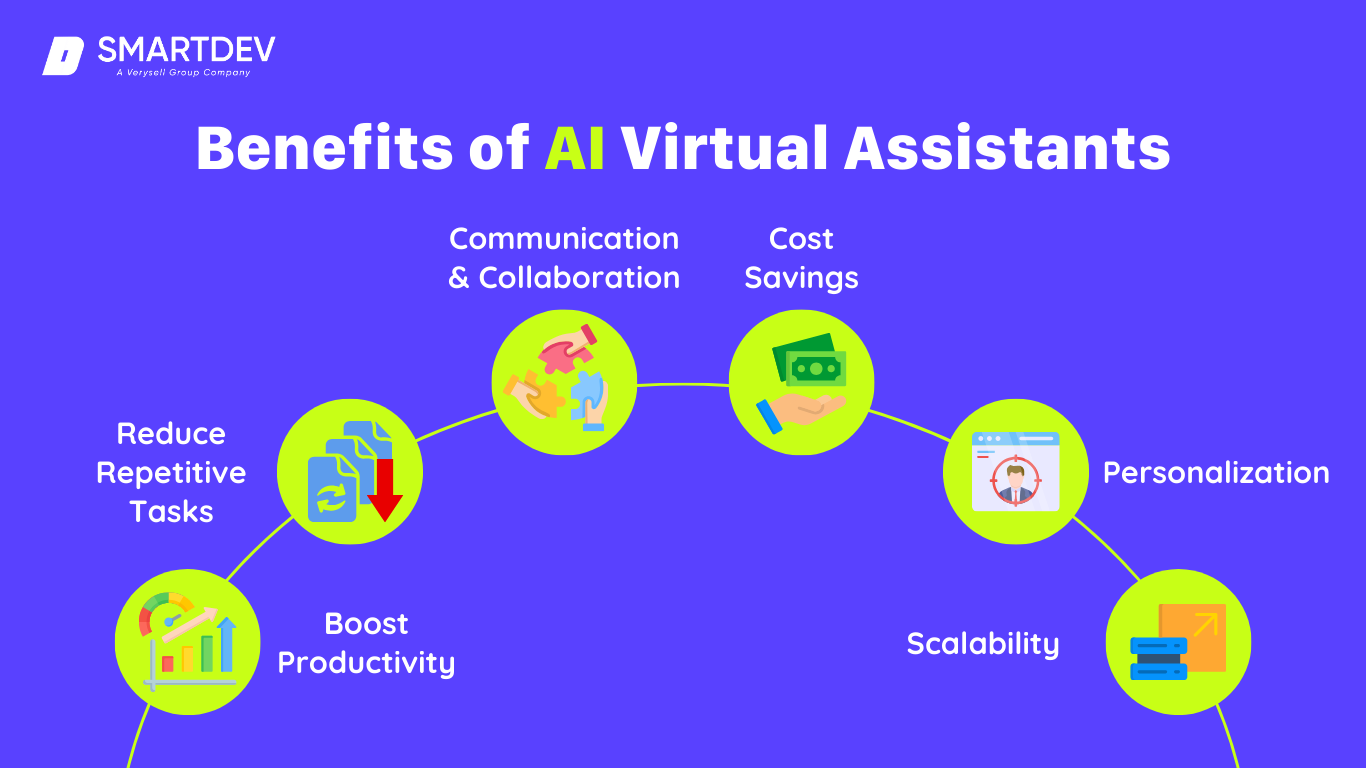
Benefits of AI Virtual Assistants
The benefits of AI-powered virtual assistants are multifaceted, impacting productivity, communication, and cost-efficiency. They automate repetitive tasks, enhance team collaboration, and provide personalized support. But the advantages don’t stop there. In this section, we’ll delve into how these tools are revolutionizing workplace dynamics, helping businesses save time and resources while driving innovation.
1. Boosting Productivity
AI assistants significantly improve productivity by automating time-consuming tasks. Employees can allocate their time and energy to high-value activities such as strategic planning and innovation.
2. Reducing Repetitive Tasks
Repetition not only reduces morale but also increases the likelihood of errors. Automating such tasks ensures accuracy and allows employees to focus on work that requires critical thinking.
3. Enhancing Communication and Collaboration
Effective communication is vital for team success. AI-powered tools improve team collaboration by automating workflows, facilitating real-time updates, and promoting seamless communication across departments.
4. Cost Savings
Replacing manual processes with AI automation leads to significant cost reductions. By streamlining workflows, businesses can save on operational expenses while maintaining or improving service quality.
5. Personalization
AI assistants adapt to individual user preferences over time. For instance, they can learn how users prefer to format reports or prioritize emails, ensuring a more personalized and intuitive experience.
6. Scalability
AI virtual assistants can scale with business needs. Whether you’re a small startup or a multinational corporation, these tools can adapt to your requirements, providing consistent support as your organization grows.
Challenges and Limitations
While AI-powered virtual assistants bring numerous benefits, they are not without challenges. Issues such as privacy concerns, limitations in handling complex tasks, and high implementation costs can pose obstacles for businesses. Addressing these challenges is essential to fully leverage the potential of these technologies. Let’s examine the key barriers organizations face when adopting AI virtual assistants.
1. Privacy and Data Security
These challenges relate to the handling and protection of sensitive information by AI systems.
- Privacy Concerns: AI assistants require access to user data, raising concerns about confidentiality and misuse.
- Data Breaches: Weak security measures can expose sensitive data to unauthorized access.
- Dependence on Reliable Data: Poor-quality or outdated data can lead to incorrect outputs and stalled AI learning.
Preventive Measures: Implement strong encryption, conduct regular security audits, and ensure compliance with data protection laws like GDPR.
2. Performance and Functional Limitations
This criterion addresses the technical and operational limits of AI assistants.
- Accuracy Issues: Misinterpretations of user commands can result in errors or inefficiency.
- Complexity Challenges: AI struggles with nuanced, creative, or judgment-intensive tasks.
- Limited Customization and Integration: Generic functionality may not align with specific business needs or legacy systems.
Preventive Measures: Continuously train AI on updated datasets, choose customizable solutions, and test for compatibility with existing tools.
3. Cost Implications and Accessibility
These challenges arise from implementing and relying on AI systems in business workflows.
- High Implementation Costs: The initial investment in AI can be prohibitive for smaller organizations. For a comprehensive guide on AI development expenses, including key factors, real-world cases, and budgeting tips, explore our latest article on AI development cost.
- Over-Reliance on AI: Dependence on AI for critical processes can lead to disruptions during system failures.
- Skill Degradation: Automation may reduce employee proficiency in manual tasks.
Preventive Measures: Adopt scalable solutions, maintain manual workflow backups, and provide ongoing employee training to balance automation and human skills.
4. Ethical and Trust Issues
These concerns are linked to the fairness, transparency, and user perception of AI systems.
- Bias in Decision-Making: AI can perpetuate discrimination if trained on biased data.
- Transparency Problems: AI often operates as a “black box,” making decision-making processes difficult to explain.
- Resistance to Adoption: Employees or customers may distrust AI due to fears about reliability or job displacement.
Preventive Measures: Audit AI systems for bias, demand transparency from vendors, and provide education about the benefits and safe use of AI.
5. User Experience and Adoption Barriers
These challenges focus on how users interact with and adapt to AI virtual assistants.
- Learning Curve: Users may struggle to understand how to use AI systems effectively.
- Limited Contextual Understanding: AI may fail to grasp nuanced or ambiguous commands.
- Trust Issues: Concerns about data security or system reliability may deter adoption.
Preventive Measures: Offer comprehensive onboarding and support, allow seamless handoffs to human agents, and emphasize user-centric design.
By categorizing these challenges, businesses can better identify potential risks and implement targeted measures to address them. A structured approach ensures that the immense benefits of AI virtual assistants are realized while minimizing their limitations.
Future Trends in AI Virtual Assistant Technology
The future of AI virtual assistants promises exciting developments, from advancements in natural language processing to increased personalization. These tools are evolving to become more intuitive, user-centric, and ethically sound. In this section, we’ll explore emerging trends shaping the future of virtual assistants and their implications for businesses worldwide.
Trend No.1: Advancements in NLP and Contextual Understanding: As NLP technology advances, AI assistants will become better at understanding complex instructions, recognizing emotional nuances, and adapting to diverse communication styles.
Trend No.2: Increased Personalization: AI assistants of the future will offer highly tailored experiences, predicting user needs and providing proactive solutions.
Trend No.3: AI Ethics and User-Centric Design: Developers will increasingly prioritize ethical AI practices, ensuring transparency, fairness, and inclusivity in virtual assistant design.
Trend No.4: Integration with Emerging Technologies: The future will likely see AI assistants integrating with emerging technologies like augmented reality (AR), virtual reality (VR), and the Internet of Things (IoT), creating even more immersive and interactive experiences.
Case Study: Revolutionizing Customer Service for Synapse
The impact of AI-powered virtual assistants is best understood through real-world examples. From retail to healthcare and tech, businesses across industries are leveraging these tools to improve operations and enhance customer experiences. In this section, we’ll highlight one of the most compelling success stories by SmartDev that demonstrates the transformative power of AI virtual assistants.
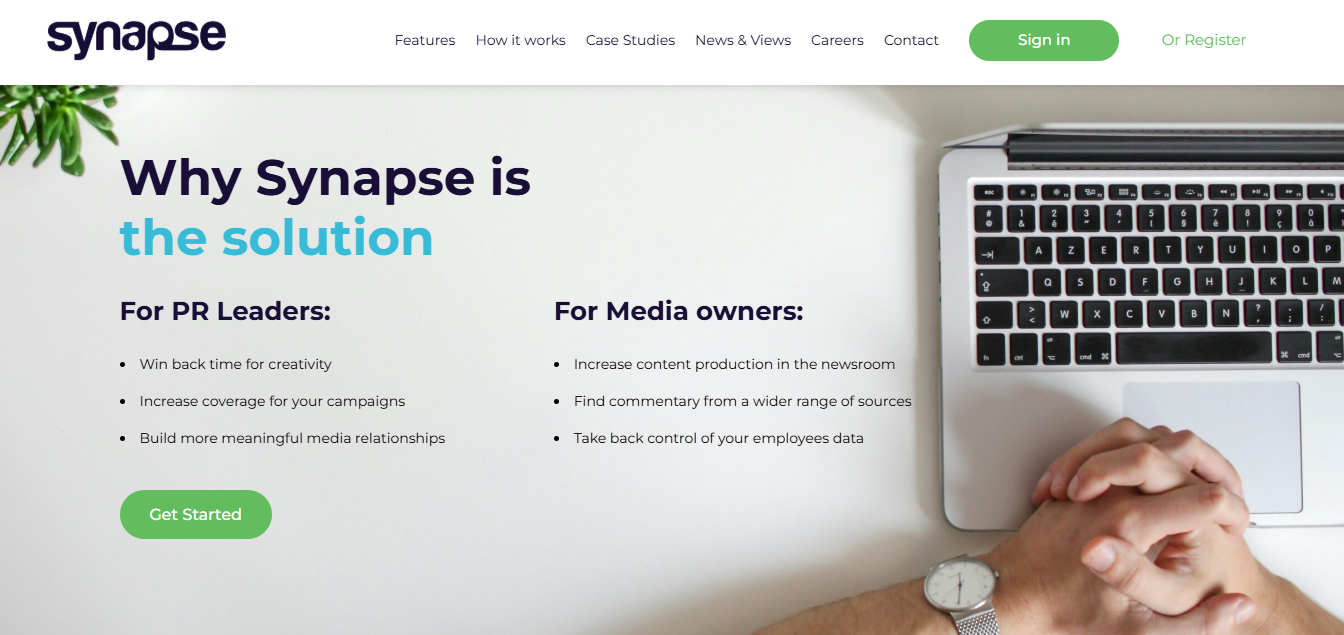
Synapse’s Website
The client in the case study is Synapse – a rapidly growing public relations (PR) platform in the UK that helps businesses manage their brand reputation, communicate with media outlets, and engage with their target audience. The platform offers tools for media monitoring, press release distribution, and campaign analytics, making it an essential resource for marketing and PR teams.
The Challenge
Synapse faced the following issues:
- Delayed Response Times: Customer service teams were overwhelmed by routine queries, causing delays in addressing complex problems.
- High Operational Costs: Expanding the support team to manage growing demand was becoming unsustainable.
- Customer Dissatisfaction: Users were frustrated with long wait times, leading to churn and negative feedback.
The Solution
SmartDev collaborated with Synapse to integrate an AI-powered virtual assistant. The assistant was designed to:
- Chatbot Integration: A conversational AI chatbot was deployed on Synapse’s website and within their platform.
- Natural Language Processing (NLP): Customized NLP models were trained to understand PR-related terminology and user intent, enabling the assistant to provide precise answers.
- Seamless Escalation: For complex inquiries, the assistant seamlessly transferred the issue to a human agent, providing context and conversation history to save time.
- Analytics Dashboard: SmartDev added an analytics tool to track common customer issues, enabling the client to continuously improve their platform and support services.
Results Achieved
a. Enhanced Customer Experience
- The AI assistant handled 70% of routine queries, providing instant responses without human intervention.
- Average response time for FAQs dropped from 3 hours to less than 1 minute.
b. Improved Scalability
- The AI system supported 24/7 customer service, accommodating global users across different time zones.
- As the platform grew, the AI assistant managed increased query volumes without additional staffing.
c. Cost Efficiency
- By automating routine tasks, the client saved an estimated 30% in customer service operational costs annually.
- Human agents could focus on high-value tasks, like resolving technical issues or assisting enterprise clients.
d. Valuable Insights
- The analytics dashboard revealed trends in customer behavior, such as the most frequently asked questions and peak inquiry times.
- These insights allowed the client to optimize their platform’s onboarding experience and improve user satisfaction.
This case demonstrates how SmartDev not only implemented an AI-powered virtual assistant but also delivered a holistic solution that aligned with Synapse’s business goals. By understanding the unique needs of the public relations industry, we designed a tool that was not just functional but transformative.
This partnership highlights the potential of AI assistants to revolutionize customer service in industries where speed, precision, and personalization are critical to success.
Choosing the Right AI Assistant
Choosing the right AI-powered virtual assistant for your organization involves careful consideration of factors like cost, features, and compatibility with existing systems. With so many options available, finding the perfect fit can be challenging. Here, we’ll provide a guide to selecting the ideal assistant to meet your unique business needs.
1. Clearly Define Your Objectives
Before exploring options, identify the core problems you want the AI assistant to solve. Are you looking to improve customer service response times? Simplify task scheduling? Automate repetitive processes? By outlining your goals, you can narrow down the features and capabilities that matter most.
Tip: Create a list of must-have functionalities and prioritize them based on the challenges your team faces daily.
2. Evaluate Compatibility with Existing Tools
For an AI assistant to deliver value, it must integrate seamlessly with your current systems. Look for solutions that connect to platforms like your CRM, project management tools, or communication software. This ensures the assistant becomes part of your workflow rather than a standalone tool.
Tip: Check for API support or integration capabilities with your existing software stack to avoid costly workarounds.
3. Prioritize User-Friendliness
No matter how advanced the technology, its success depends on how easily it can be adopted by your team. Choose an assistant with an intuitive interface and straightforward commands that require minimal training for employees to start using it effectively.
Tip: Consider conducting a pilot test with a small team to assess usability before rolling it out across the organization.
4. Assess Scalability for Long-Term Growth
A good AI assistant should adapt to your evolving needs. Whether your team grows, your workflows become more complex, or your industry standards change, the assistant should scale without losing efficiency.
Tip: Opt for solutions that offer flexible plans or modular features, allowing you to expand its capabilities as needed.
5. Ensure Strong Data Security
AI assistants often handle sensitive information, so robust data security measures are non-negotiable. Look for features like encryption, compliance with regulations (e.g., GDPR, HIPAA), and access control settings to protect your data.
Tip: Always review the provider’s security certifications and ask about their data handling policies.
6. Evaluate ROI Beyond Cost
While cost is an important factor, focus on the value the assistant brings to your business. Consider how much time it will save, the level of efficiency it introduces, and how it can positively impact customer satisfaction or employee productivity.
Tip: Calculate potential cost savings in terms of time and resources to better understand the assistant’s long-term value.
7. Seek Solutions That Can Be Customized
Every business has unique needs, and a one-size-fits-all approach rarely delivers optimal results. Look for AI assistants that offer customization options to align with your industry-specific requirements or internal processes.
Tip: Engage with vendors who are open to tailoring features or workflows based on your input.
8. Stay Informed About Future Trends
AI technology evolves rapidly, and investing in a forward-looking solution can future-proof your operations. Features like advanced natural language processing (NLP), contextual understanding, and predictive analytics are increasingly becoming essential.
Tip: Research emerging trends in AI assistant technology and choose a solution that’s built to incorporate these advancements.
9. Build a Partnership with the Provider
Beyond the tool itself, the support you receive from the solution provider is critical. A reliable partner will help with implementation, provide ongoing support, and ensure the assistant continues to meet your needs as your business evolves.
Tip: Look for providers with a strong reputation for customer service and technical expertise, as they’ll play a key role in ensuring your success with the AI assistant.
Choosing the right AI virtual assistant involves more than selecting a feature-rich tool; it’s about ensuring it integrates seamlessly, aligns with your goals, and evolves with your business. By following these tips, you’ll be better equipped to unlock the full potential of AI assistants and create meaningful improvements in efficiency and productivity.
Conclusion
AI-powered personal assistants have already made a significant impact on our daily lives, and their potential for future advancements is truly exciting. With their cutting-edge capabilities and continuous evolution, these virtual assistants are set to play an even more significant role in shaping the future of technology and productivity. They are also anticipated to become more proactive, not merely responding to direct queries but anticipating needs and providing solutions even before they are requested.
As technology evolves, these assistants will become even more integrated into our routines, making tasks simpler and more efficient, and ultimately shaping the future of personal and professional productivity.
SmartDev’s Role
SmartDev’s AI solutions can help businesses leverage AI technology to create seamless, personalized, and customer-centric experiences. They can assist in implementing AI-based customer service systems for fintech apps, providing investment advice, and handling customer queries.
SmartDev’s AI solutions can also help businesses automate tasks, improve natural language understanding, and enhance content creation. Additionally, SmartDev’s AI solutions can learn from user interactions, adapt to changing contexts, and stay up-to-date with the latest trends and advancements in their respective fields, ultimately improving their performance and relevance over time,
Additionally, SmartDev offers AI consulting, strategy development, solution development, and data analytics services, empowering businesses, including startups, to leverage the transformative power of AI. By partnering with SmartDev, businesses can gain a competitive edge, unlock new opportunities, optimize operations, and deliver exceptional customer experiences through the implementation of AI, including virtual assistants.
—
References
- Case Studies | IBM Watsonx Assistant | IBM
- 185 Real-World Generative AI Use Cases | Google Cloud
- Gen AI | Best Buy Case Study | Accenture
- Why Virtual Assistants Fail and How to Avoid It | IBM Developer
- 10 Best AI Virtual Assistants in 2024 | ClickUp
- Pros And Cons Of AI-Enhanced Virtual Assistants | Restackio
- Virtual assistants and chatbots using AI are here to stay | World Economic Forum
- So Human It’s Scary: My Day Alone Talking to Bots That Sound Like Us | The Wall Street Journal
- Microsoft’s AI bots can pick up office workers’ tedious tasks | The Times
- Former Google X employees come out of stealth with TwinMind, an AI app that hears and remembers everything about you | Business Insider

